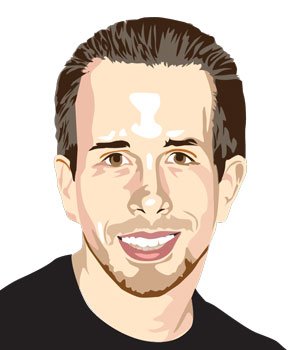01. JASON L. BAPTISTE, 25
ONSWIPE
Adapts content for touch-enabled devices in less than three minutes
The idea for OnSwipe struck while Jason Baptiste was searching for a way to make his writing about entrepreneurship from Onstartups.com available for the iPad. “From that came this whole big thing that would ultimately make it easier to publish beautiful content on tablets,” Baptiste says. He’s working with WordPress, which uses OnSwipe to power its 18.6 million blogs, and is in talks with several magazine publishers. “We see a world where people aren’t making money with ugly text link ads, they’re making it with beautiful full-page ads,” Baptiste explains.
As touch and swipe technology becomes ubiquitous, Baptiste sees enormous growth potential: New York-based OnSwipe thinks its projections for Q3 of 2012 will be met by the end of this year. Baptiste’s publishing technology embodies exactly what he loves about the start-up world: “You can recognize something you’d like to see in the world and you can make it happen.”

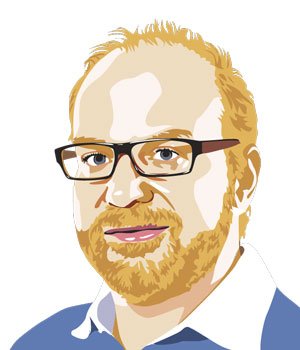
02. PERRY BLACHER, 37
COVESTOR
Investing that mimics the pros
“If mutual funds were being invented today, this is probably how they would do it,” says Perry Blacher of Covestor, launched in June of 2007. The former McKinsey consultant decided to invest in a Venezuelan oil project after a colleague— now the chairman of Covestor—told him an expert in the field was making the same trade. Along the way, he realized that other investors could benefit from the opportunity to invest as the experts do. And so he decided to start Covestor, a website that allows users to follow the portfolios of other investors and replicate their trades.
Today, more than 160 wealth managers and 30,000 followers have portfolios on Covestor; the followers pay a fee, which is split between the site and the wealth managers. “We have a live view into their brokerage accounts, and you can filter particular kinds of trades,” Blacher says. “In a way, it’s a custom fund.” Blacher loves the autonomy and adrenaline of entrepreneurship. “When you’re taking on an established industry via the internet,” he says, “you’re making things possible that weren’t before.”
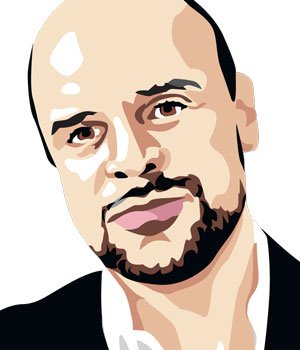
03. DANIELE CALABRESE, 36
SOUNDTRCKR.COM
Combines social media and streaming music
Raised in southern Italy, Daniele Calabrese doesn’t have a typical entrepreneur’s background: He came to the United States to study political science at George Washington University, then went to work at the World Bank in communications, marketing and mobile platform development. After some years there, he recalls, “I realized that I had plateaued and thought, ‘Why do this for my boss if I can do it for myself?’”

An aficionado of music and radio, Calabrese believed that “it was clear that streaming, the cloud, would supercede MP3 downloads.” And so in late 2008 he left the World Bank and started building Soundtrckr.com. The site lets users create stations based on their musical tastes, which they can then share with friends. Users can also follow the stations of other friends or people in their physical vicinity.
For two years Calabrese and his team (now seven people) worked to ink the music licenses, build the site and attract financing. They launched Soundtrckr in November 2010, and as of this April had 725,000 unique visitors. They’ve also built applications for iPhone, iPad, Android and other portable devices. Soundtrckr plans to make money from advertising and subscriptions; it has also partnered with Ticketmaster to sell tickets online. (Soundtrckr will tell you what concerts your friends are attending and what bands are playing nearby.) By the end of 2012, Calabrese hopes to have 5 million users, 60 percent of whom are overseas, and applications for internet television and cars.

04. HIL DAVIS, 38
J. HILBURN
Bespoke men’s apparel
While researching equities for Citadel Investment Group in Dallas in 2006, Hil Davis read Robert Hagstrom’s The Warren Buffett Way and discovered that The Pampered Chef, a direct seller of housewares, was one of Buffett’s top three investments—ever. After learning more about direct sales through his work covering Amazon, Davis decided to apply the approach to high-end men’s clothing. He launched jhilburn.com—the URL uses his full name—in October 2007. Selling only custom shirts, he did $100,000 in business by year’s end. In 2008, revenue grew to nearly $1 million; the addition of sweaters, trousers and accessories helped boost sales to $10 million in 2010. In June, the site began selling custom suits.
J. Hilburn now has over 40,000 clients, and sales are on track to surpass $20 million annually. “On Wall street, I had the opportunity to make a lot of money, but this provided me the opportunity to really build something,” Davis says.

05. BRICE GOGUET, 33
VOLTAIRE DESIGN
Exquisite equestrian goods, particularly saddles and boots
“There are three people in the world who know both the American and European market in high-end equestrian goods,” Brice Goguet says, “and I am one of them.”
After heading the North American operations of luxury saddle maker Devoucoux for six years, native Frenchman Goguet left in February 2010 to apply that expertise to his own venture. “The reason this company exists is because I couldn’t fully express my potential,” he explains. “iIwas in a box that was a bit too small.” Seven months later, he launched his bi-continental business (production takes place in France, distribution in the U.S.) that combines the tradition of luxury saddle making with modern tools. In less than a year of operation, he boasts over 300 clients, including two-time Olympic gold medalist Beezie Madden.
For Goguet, the beauty of entrepreneurship is that it doesn’t feel like work. “I made my passion my job, so I never have to work again in my life,” he says.
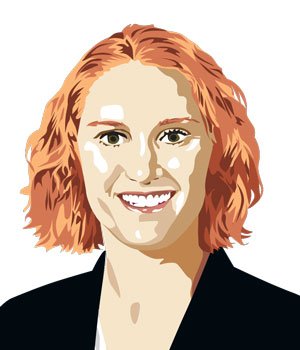
06. CAPTAIN (RET.) DAWN HALFAKER, 31
HALFAKER & ASSOCIATES
Security and defense consulting
In 2004, Dawn Halfaker was three years into a promising military career as an army officer when she sustained serious wounds from a rocket-propelled grenade during a patrol mission in Iraq. Halfaker, who would undergo some 20 operations including the amputation of her right arm, spent 10 months in recovery during which she considered her next step. “I was looking for an opportunity that allowed me to stay focused on and contribute to what was going on overseas,” Halfaker says. “I went on several interviews, but didn’t really find anything that suited me.”
So in January 2006, Halfaker launched her own Arlington, Va.-based defense firm working on security threats and related issues. What started as a one-woman show began to attract employees with similar goals, and today, almost 75 percent of Halfaker’s 150 employees are military veterans. Her client list includes the Department of Defense, the U.S. Air Force and Navy, and the Department of Homeland Security, but Halfaker declines to say exactly what her firm does for them. “Our culture is unique,” she explains. “We all are continuing to serve, continuing to be a part of the solution.”

07. RYAN HEALY, 27
BRAZEN CAREERIST
Career networking website
Most career-oriented social networking sites connect people with acquaintances or co-workers. With Brazen Careerist, Ryan Healy had a different idea: help high-achieving young professionals connect with people they don’t know. Healy started BrazenCareerist.com, originally a blog, while toiling as a finance consultant at IBM. He did some recruiting work for the company and quickly tired of hearing—mostly from older executives—how lazy and entitled young people are today. “That’s not my generation,” Healy says.
Healy has raised $3 million in angel funding to date, with another financing round planned for later this year. More than 100,000 users from finance, marketing and other professions visit the site for features such as the new network roulette, which uses the techniques of speed-dating to facilitate professional connections. A similar feature will soon pair professionals with employers. Healy expects such virtual career fairs to be the main revenue source for the firm (companies pay a fee to participate; professionals don’t). Job listings and advertising—Citibank and AT&tT are clients—also generate revenue.
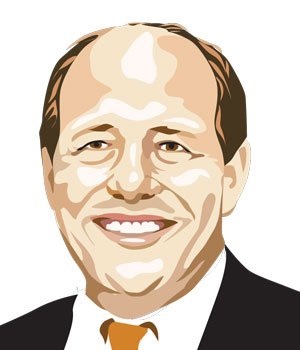
08. LARRY MUELLER, 60
CUVÉE VENTURES , CUV É E ESCAPES
Cuvée Ventures is a private equity firm that buys and sells high-end properties; Cuvée Escapes rents the properties out in the interim
Larry Mueller started Cuvée Ventures and Cuvée Escapes (cuveeventures.com) when he had a mid-career epiphany. As a high-level executive at IBM who headed and took public several small technology companies, Mueller had done well for himself. But while in the process of working with Goldman Sachs to diversify his portfolio, “I started to realize that, no matter how much money you make, you aren’t really enjoying life.”
So in 2005 Mueller came up with the idea of an investment fund that would not only invest in high-end real estate, but would allow its investors to use those properties until they were later sold. The years ahead would prove devastating to other destination clubs, but Mueller structured Cuvée in a way that protected it from the bursting real estate bubble. He limited his first fund to a small number of investors who would pay $1.35 million for a full share. After raising some $20 million, Cuvée would pay cash for its properties then pay the carrying costs through rental income.
Following the same model, Cuvée has since opened several new funds, and Mueller is passionate about the business. “A lot of people who started these destination clubs were out to make a quick buck,” he says. “I pay myself zero—I make money the same way the investors make money. We believe we can make a 5 to 12 percent annualized return without leverage.”

09. MICHELLE NG, 24
YOUNG & NG
Artful fashion design
When Michelle Ng launched her first collection just nine months ago, the New Zealand-born art school grad showed she had the design chops to create edgy but elegant jewelry, such as cuff bracelets inspired by internal organs and hair combs suggestive of stained glass. What wasn’t obvious from the strong lines of her designs was her equally strong business sense. “I saw a hole in the market,” she says. “There was really no one doing high-end headpieces, and I decided that would be my niche.”
Though she’d long dreamed of designing for a fashion house, Ng changed her mind after a stint as a creative assistant at a handbag company: “I learned a lot about the business side, and a lot about production, but I realized, I can do this myself. I didn’t want to compete for positions. I want to work with someone to build relationships and create positions.” To that end, Ng also opened her own Manhattan showroom, called NL, in April, to give herself and other small designers a showcase for their work.

10. DAVID PACHTER, 45
NEARSAY.COM
A hyperlocal website
“What do I like about starting a business?” David Pachter says. “This part of it—right now. The satisfaction of knowing that you can create something that has lasting value.”
Pachter is referring to the 2010 birth of Nearsay.com, the website he started to publish local news and promote local merchants. Nearsay is a mix of blogger-generated content, aggregated news stories, and targeted offers and advertising from local merchants. At the moment, the site only covers Manhattan neighborhoods, but it’s adding Brooklyn this month, and Pachter hopes to expand to cities nationwide.
Pachter co-founded Nearsay with partner Trevor Sumner after, he says, “I was trying to find out what was going on in my neighborhood and couldn’t do it.” A self-described news junkie, he decided to build a “HuffPo-styled platform” that would attract merchants—he’s identified 100,000 possible advertisers in New York City—who want to reach readers of local news. Nearsay, which is what the tech world calls a “Hyperlocal” site, now has 120,000 unique visitors a month.

11. AVNER RONEN, 35
BOXEE
Broadcasts video to your television
“As with many start-ups, Boxee came from a problem I was trying to resolve,” says Avner Ronen. A tech-start-up veteran who arrived in New York from Israel in 1999 with his instant-messaging application, Odigo, he’d had a computer hooked up to his television since 2003, and noticed he was spending more time watching what was online than what was on TV. After four years as the head of M&A at Comverse, which had acquired Odigo, Ronen left in 2007 to start Boxee. Ronen thought consumers would find his original setup appealing, “but it was just too geeky,” he says. So, in addition to offering Boxee’s software free online (more than 1.7 million users have downloaded it), Ronen and his team built a box that connects to a television as simply as a DVD player and has a sophisticated remote control. The devices, available at boxee.com, cost $199.
Apple and Google dominate the market but Ronen thrives on the challenge of perfecting the user experience. “I love the roller coaster of the start-up life,” Ronen says. “The excitement of being able to drive everything from scratch is second to none.”
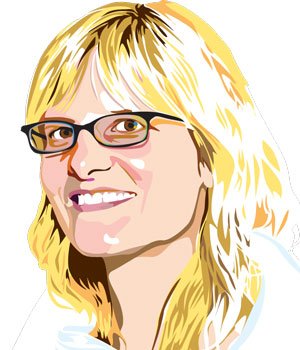
12. ALIX SOUBIRAN, 36
PRINCES & CROWS
Hand-drawn and hand-painted wallpaper and décor, including a children’s line called Little Princes
Born and raised in Paris, Alix Soubiran comes from a family known for its creativity: her grandfather, André, is a celebrated French author. But in 2000, the young muralist left her country for an American “adventure.” Moving to Orlando, Fla., she employed her artistic skills to launch her first company, creating custom murals for interiors. “I started small and based it on my talents,” Soubiran recalls. After winning commissions for mural jobs in Paris, London, San Tropez and, yes, Florida, Soubiran relocated to Los Angeles in 2007 and began a new project— wallpaper.
“It was based on wanting to still use my talents but in a new medium,” Soubiran says. At first, Soubiran relied on word of mouth to drive sales of her beautifully detailed wallpaper, which costs about $135 a roll. But her business has expanded exponentially since opening her online store (princesandcrows.com) in 2009.
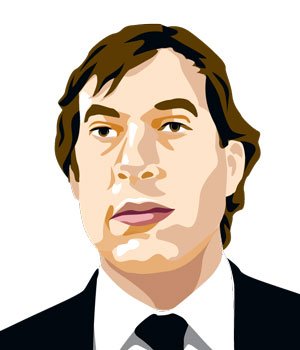
13. PAOLO SPADA, 40
SPADACONCEPT
Custom automobile design and supercars
Like many entrepreneurs, Paolo Spada gets his creative streak from family; his father, Ercole Spada, fashioned classic car designs for Aston Martin, Alfa Romeo and BMW. After designing cars for Smart and Honda, Spada fils decided to team up with his father in 2006 to create SpadaConcept, an auto design studio, and its offshoot, Spada Vetture Sport, which produces niche supercars. While SpadaConcept sells its designs to other companies, Spada Vetture Sport makes a very limited number of custom cars—about 10 per year, according to Spada. “That low production means we can satisfy each customer by customizing the car in a different way,” he explains. Their newest, the Coda-ronca Monza, features a 7.0 liter V8 engine and 700 horsepower. It looks something like a Corvette crossed with a rocket.
SpadaConcept has also designed boats, motorcycles and Formula One helmets. “The beauty of working with my father is that we have a very small team that we’re training, and it takes his heritage and transforms that into actual building,” Spada says.
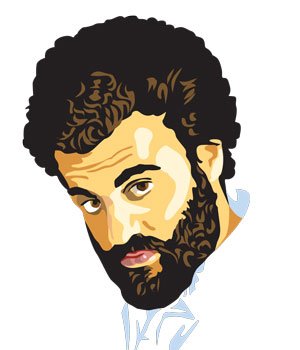
14. GABRIEL STULMAN, 30
JEFFREY’S GROCERY, JOSEPH LEONARD AND FEDORA
Neighborhood restaurants with culinary chops
Gabriel Stulman’s restaurants, all located in New York’s West Village and opened in the last two years, are deliberately idiosyncratic. Joseph Leonard has only seven tables, Jeffrey’s grocery’s tin-ceiling décor is a play on 19th century storefronts and you have to step down into Fedora’s below-ground-level space. In other words, they’re quirky. More important, they serve the kind of food—oysters, duck rillettes, braised short rib rarebit—found at New York’s most sophisticated establishments in a setting as unpretentious as your favorite local haunt. As a result, New Yorkers clamor to get in, the city’s food critics pay homage and the restaurants generate a reported $8 million in combined revenue.
All this is particularly impressive considering that Stulman is a recent restaurateur. He opened his first places, Little Owl and Market Table, with partners in 2005, soon after he graduated from the University of Wisconsin and moved to New York in 2003. But Stulman severed those business relationships after learning a valuable lesson about entrepreneurship: “Never have an equal partner,” he has said. “Someone has to be in control.”

15. PETER THUM, 43
FONDERIE QUARANTE-SEPT (FOUNDRY 47)
Turning guns into gems
“I’m a businessperson, and I think that social problems can be solved with business,” says Peter Thum, who has a history of trying to do just that. In 2001, Thum spent six months working in Africa as a consultant for McKinsey & Co. and was struck by the sight of women and girls constantly toting water. He founded Ethos, a brand of elegantly packaged bottled water; a percentage of revenue went to humanitarian water programs in Africa. Though financing was a challenge—potential investors thought Thum planned to give away too much money, Ethos found a fan in Starbucks CEO Howard Schultz, who bought the company in 2005 for $8 million.
The experience led to Thum’s current project, Fonderie Quarante-Sept (fonderie47.com). While visiting an Ethos project in Kenya in 2008, Thum says, he saw children armed with assault weapons. He came up with the idea of buying assault weapons floating around African nations—Congo, Burundi and Rwanda, to start—and melting them down. Then he’d take the steel and work with high-end jewelry designers to create custom pieces.
Already Thum has purchased and destroyed some 2,000 machine guns. The company’s first piece is a set of cufflinks for $30,000. Returns fund the company and buy more machine guns, so that they can never wreak havoc again.
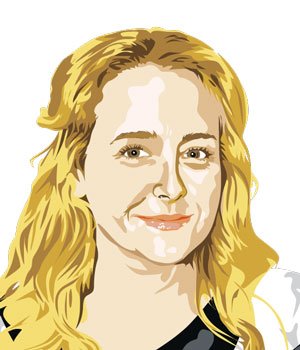
16. ALEXA VON TOBEL, 27
LEARNVEST
Financial website for young women
A Florida native, Alexa Von Tobel graduated from Harvard College in 2006 before working as a trader for two years at Morgan Stanley. She had just started at Harvard Business School in the fall of 2008 when Lehman Brothers collapsed. Suddenly, the job market for aspiring bankers didn’t look so promising. “I’d learned about global finance,” says Von Tobel. “But I hadn’t learned about personal finance—and neither had any of my friends on Wall Street, who were all losing their jobs and hadn’t saved anything.”
Inspired, Von Tobel wrote a 75-page business proposal, took a leave of absence from HBS and launched New York-based LearnVest to advise young women how to handle their money. Knowing that web-based businesses in particular benefit from targeting a niche audience, Von Tobel focused on women— the “chief household officers,” as she calls them.
Learnvest.com gets about 500,000 visits a month from users drawn to posts by entrepreneurs and Wall Street executives; “bootcamp” programs that instruct women on getting out of debt, cutting costs and investing; and tools for budgeting and retirement planning. The company, which now has 29 employees, landed $4.5 million in funding from Accel Partners in 2010. Von Tobel expects revenues to come from advertising: Chase Blueprint, Allied Bank and retailers such as The Limited and Reebok have all signed on.
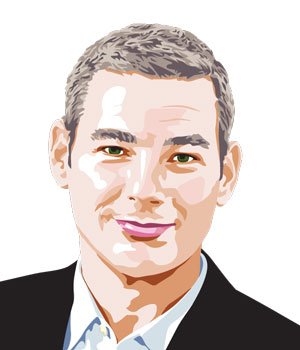
17. DOUG TOMLINSON, 41
VINO VOLO
High-end wine bars at airports
As a Deloitte management consultant, Doug Tomlinson developed businesses for large companies, so Vino Volo wasn’t his first new business plan. “It was probably my 80th,” he says, “but it was the one I couldn’t talk myself out of doing.”
As you might expect, Tomlinson came up with the idea for a high-end airport wine bar while in an airport, looking for a place to celebrate the completion of a project over something nicer than Miller on tap. Vino Volo—there are now 15 of them in airports around the country—combines local products (Texas Hill Country wine in San Antonio; Lake Michigan wine in Detroit) with an ever-evolving national wine list and surprisingly sophisticated food. (The better, Tomlinson says, to assure customers that the wines will be equally excellent.) Tomlinson plans to have 30 locations by the end of this year and 50 by the end of 2012.
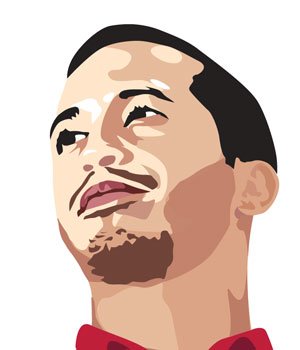
18. JEREMY TOOKER, 32
FOUR BARREL COFFEE
Coffee retailer and wholesaler
San Francisco’s Four Barrel Coffee, which Jeremy Tooker opened in 2008, isn’t your typical coffee shop. To discourage customers more interested in writing the great American novel than interacting with others, Tooker has banned Wi-Fi. He won’t offer coffee-debasing skim milk. There’s no tea or Chai. And though wholesaling is an important part of the business, Tooker won’t partner with just anyone; he’s looking for businesses that share his exacting standards, such as Danny Meyer’s latest New York restaurant, Maialino.
Tooker’s approach is unabashedly elitist, but the Bay City’s coffee-obsessed approve and the Portland native makes no apologies. He’s worked in coffee shops half his life and helped launch San Francisco’s Ritual Roasters in 2005, another mecca for coffee fanatics. “This time I didn’t want to compromise in any form,” he says. “It’s my business and I get to orient it towards customers who appreciate the no-compromise approach.”
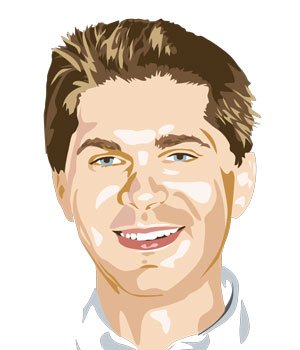
19. ZAC TRIEMERT, 36
LUCKY BUCKET BREWING COMPANY & SOLAS DISTILLERY
Makers of beer, vodka, rum and a forthcoming malt whiskey
As a pre-med student studying microbiology and chemistry at the University of Wisconsin, Zac Triemert attended a talk given by Randy H ughes, the brewmaster of G. Heileman Brewing Company. “I was hooked,” Triemert says. He began his career as a commercial brewer in 2002, then moved to Scotland to earn his master’s degree in brewing and distilling, something only a handful of American brewers can boast. But Triemert faced a major roadblock in starting his own brewery/ distillery in La Vista, Nebraska—the state’s Prohibition-era laws didn’t permit microdistillery licenses. Undeterred, he enlisted the help of bill writers and State Senator John Dynowiecki to create the Craft Distilling Bill, which Governor Dave Heineman signed into law in March 2007. That gave Triemert the green light to seek funding for Lucky Bucket, and the brewery’s first beer was sold in January 2009 (luckybucketbrewery.com).
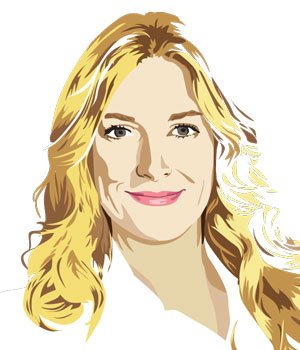
20. HEATHER WIESE-ALEXANDER, 36
BELL ’INVITO
Hand-pressed paper products
Working as an art director at Neiman Marcus, Heather Wiese-Alexander began to dream about becoming an entrepreneur—“I didn’t think of it like that right away, just that I wanted to write my own story,” she says—and it brought her to Italy, whose luxury goods she had long admired for their craftsmanship, in search of a business idea. She visited artisanal leatherworking, bookbinding and mosaic shops. Then, back home in Texas, she stumbled upon some unused 19th century letterpresses owned by her husband’s family, and came up with the items she wanted to create: elegant paper products, each designed, drawn and pressed by hand on Italian paper.
Wiese-Alexander started Bell ’Invito (“beautiful invitation”) as a solo operation out of her basement in Dallas in 2004. The company, which now consists of 20 employees and includes an 11,000-square foot printing facility, offers a line of boxed cards (up to $115 for 10) in addition to its couture line of handmade invitations (from $8.75 to $150 each). Wiese-Alexander sells them through her shop, Nest, on McKinney Avenue in Dallas as well as online (bellinvito.com) and at retailers such as Bergdorf Goodman, Barneys and Neiman Marcus.

